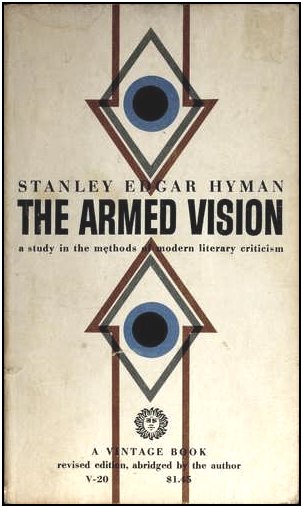A Circle of Quiet
From the Harvard Math Table page:
“No Math table this week. We will reconvene next week on March 14 for a special Pi Day talk by Paul Bamberg.”
Some friends of mine are in this band.
They’re playing in a bar on Diversey,
way down the bill, around…
I said I’d be there.
Great.
They’re all in the math department.
They’re good.
They have this song called “i.”
You’d like it. Lowercase i.
They just stand there.
They don’t play anything for three minutes.
Imaginary number?
It’s a math joke.
You see why they’re way down the bill. |
From the April 2006 Notices of the American Mathematical Society, a footnote in a review by Juliette Kennedy (pdf) of Rebecca Goldstein’s Incompleteness:
4 There is a growing literature in the area of postmodern commentaries of [sic] Gödel’s theorems. For example, Régis Debray has used Gödel’s theorems to demonstrate the logical inconsistency of self-government. For a critical view of this and related developments, see Bricmont and Sokal’s Fashionable Nonsense [13]. For a more positive view see Michael Harris’s review of the latter, “I know what you mean!” [9]….
[9] MICHAEL HARRIS, “I know what you mean!,” http://www.math.jussieu.fr/~harris/Iknow.pdf.
[13] ALAN SOKAL and JEAN BRICMONT, Fashionable Nonsense, Picador, 1999.
Following the trail marked by Ms. Kennedy, we find the following in Harris’s paper:
“Their [Sokal’s and Bricmont’s] philosophy of mathematics, for instance, is summarized in the sentence ‘A mathematical constant like  doesn’t change, even if the idea one has about it may change.’ ( p. 263). This claim, referring to a ‘crescendo of absurdity’ in Sokal’s original hoax in Social Text, is criticized by anthropologist Joan Fujimura, in an article translated for IS*. Most of Fujimura’s article consists of an astonishingly bland account of the history of non-euclidean geometry, in which she points out that the ratio of the circumference to the diameter depends on the metric. Sokal and Bricmont know this, and Fujimura’s remarks are about as helpful as FN’s** referral of Quine’s readers to Hume (p. 70). Anyway, Sokal explicitly referred to “Euclid’s pi”, presumably to avoid trivial objections like Fujimura’s — wasted effort on both sides.32 If one insists on making trivial objections, one might recall that the theorem
doesn’t change, even if the idea one has about it may change.’ ( p. 263). This claim, referring to a ‘crescendo of absurdity’ in Sokal’s original hoax in Social Text, is criticized by anthropologist Joan Fujimura, in an article translated for IS*. Most of Fujimura’s article consists of an astonishingly bland account of the history of non-euclidean geometry, in which she points out that the ratio of the circumference to the diameter depends on the metric. Sokal and Bricmont know this, and Fujimura’s remarks are about as helpful as FN’s** referral of Quine’s readers to Hume (p. 70). Anyway, Sokal explicitly referred to “Euclid’s pi”, presumably to avoid trivial objections like Fujimura’s — wasted effort on both sides.32 If one insists on making trivial objections, one might recall that the theorem
that p is transcendental can be stated as follows: the homomorphism Q[X] –> R taking X to  is injective. In other words,
is injective. In other words,  can be identified algebraically with X, the variable par excellence.33
can be identified algebraically with X, the variable par excellence.33

More interestingly, one can ask what kind of object  was before the formal definition of real numbers. To assume the real numbers were there all along, waiting to be defined, is to adhere to a form of Platonism.34 Dedekind wouldn’t have agreed.35 In a debate marked by the accusation that postmodern writers deny the reality of the external world, it is a peculiar move, to say the least, to make mathematical Platonism a litmus test for rationality.36 Not that it makes any more sense simply to declare Platonism out of bounds, like Lévy-Leblond, who calls Stephen Weinberg’s gloss on Sokal’s comment ‘une absurdité, tant il est clair que la signification d’un concept quelconque est évidemment affectée par sa mise en oeuvre dans un contexte nouveau!’37 Now I find it hard to defend Platonism with a straight face, and I prefer to regard the formula
was before the formal definition of real numbers. To assume the real numbers were there all along, waiting to be defined, is to adhere to a form of Platonism.34 Dedekind wouldn’t have agreed.35 In a debate marked by the accusation that postmodern writers deny the reality of the external world, it is a peculiar move, to say the least, to make mathematical Platonism a litmus test for rationality.36 Not that it makes any more sense simply to declare Platonism out of bounds, like Lévy-Leblond, who calls Stephen Weinberg’s gloss on Sokal’s comment ‘une absurdité, tant il est clair que la signification d’un concept quelconque est évidemment affectée par sa mise en oeuvre dans un contexte nouveau!’37 Now I find it hard to defend Platonism with a straight face, and I prefer to regard the formula

as a creation rather than a discovery. But Platonism does correspond to the familiar experience that there is something about mathematics, and not just about other mathematicians, that precisely doesn’t let us get away with saying ‘évidemment’!38
32 There are many circles in Euclid, but no pi, so I can’t think of any other reason for Sokal to have written ‘Euclid’s pi,’ unless this anachronism was an intentional part of the hoax. Sokal’s full quotation was ‘the  of Euclid and the G of Newton, formerly thought to be constant and universal, are now perceived in their ineluctable historicity.’ But there is no need to invoke non-Euclidean geometry to perceive the historicity of the circle, or of pi: see Catherine Goldstein’s ‘L’un est l’autre: pour une histoire du cercle,’ in M. Serres, Elements d’histoire des sciences, Bordas, 1989, pp. 129-149.
of Euclid and the G of Newton, formerly thought to be constant and universal, are now perceived in their ineluctable historicity.’ But there is no need to invoke non-Euclidean geometry to perceive the historicity of the circle, or of pi: see Catherine Goldstein’s ‘L’un est l’autre: pour une histoire du cercle,’ in M. Serres, Elements d’histoire des sciences, Bordas, 1989, pp. 129-149.
33 This is not mere sophistry: the construction of models over number fields actually uses arguments of this kind. A careless construction of the equations defining modular curves may make it appear that pi is included in their field of scalars.
34 Unless you claim, like the present French Minister of Education [at the time of writing, i.e. 1999], that real numbers exist in nature, while imaginary numbers were invented by mathematicians. Thus  would be a physical constant, like the mass of the electron, that can be determined experimentally with increasing accuracy, say by measuring physical circles with ever more sensitive rulers. This sort of position has not been welcomed by most French mathematicians.
would be a physical constant, like the mass of the electron, that can be determined experimentally with increasing accuracy, say by measuring physical circles with ever more sensitive rulers. This sort of position has not been welcomed by most French mathematicians.
35 Cf. M. Kline, Mathematics The Loss of Certainty, p. 324.
36 Compare Morris Hirsch’s remarks in BAMS April 94.
37 IS*, p. 38, footnote 26. Weinberg’s remarks are contained in his article “Sokal’s Hoax,” in the New York Review of Books, August 8, 1996.
38 Metaphors from virtual reality may help here.”
* Earlier defined by Harris as “Impostures Scientifiques (IS), a collection of articles compiled or commissioned by Baudouin Jurdant and published simultaneously as an issue of the journal Alliage and as a book by La Découverte press.”
** Earlier defined by Harris as “Fashionable Nonsense (FN), the North American translation of Impostures Intellectuelles.”
What is the moral of all this French noise?
Perhaps that, in spite of the contemptible nonsense at last summer’s Mykonos conference on mathematics and narrative, stories do have an important role to play in mathematics — specifically, in the history of mathematics.
Despite his disdain for Platonism, exemplified in his remarks on the noteworthy connection of pi with the zeta function in the formula given above, Harris has performed a valuable service to mathematics by pointing out the excellent historical work of Catherine Goldstein. Ms. Goldstein has demonstrated that even a French nominalist can be a first-rate scholar. Her essay on circles that Harris cites in a French version is also available in English, and will repay the study of those who, like Barry Mazur and other Harvard savants, are much too careless with the facts of history. They should consult her “Stories of the Circle,” pp. 160-190 in A History of Scientific Thought, edited by Michel Serres, Blackwell Publishers (December 1995).
For the historically-challenged mathematicians of Harvard, this essay would provide a valuable supplement to the upcoming “Pi Day” talk by Bamberg.
For those who insist on limiting their attention to mathematics proper, and ignoring its history, a suitable Pi Day observance might include becoming familiar with various proofs of the formula, pictured above, that connects pi with the zeta function of 2. For a survey, see Robin Chapman, Evaluating Zeta(2) (pdf). Zeta functions in a much wider context will be discussed at next May’s politically correct “Women in Mathematics” program at Princeton, “Zeta Functions All the Way” (pdf).











 doesn’t change, even if the idea one has about it may change.’ ( p. 263). This claim, referring to a ‘crescendo of absurdity’ in Sokal’s original hoax in Social Text, is criticized by anthropologist Joan Fujimura, in an article translated for IS*. Most of Fujimura’s article consists of an astonishingly bland account of the history of non-euclidean geometry, in which she points out that the ratio of the circumference to the diameter depends on the metric. Sokal and Bricmont know this, and Fujimura’s remarks are about as helpful as FN’s** referral of Quine’s readers to Hume (p. 70). Anyway, Sokal explicitly referred to “Euclid’s pi”, presumably to avoid trivial objections like Fujimura’s — wasted effort on both sides.32 If one insists on making trivial objections, one might recall that the theorem
doesn’t change, even if the idea one has about it may change.’ ( p. 263). This claim, referring to a ‘crescendo of absurdity’ in Sokal’s original hoax in Social Text, is criticized by anthropologist Joan Fujimura, in an article translated for IS*. Most of Fujimura’s article consists of an astonishingly bland account of the history of non-euclidean geometry, in which she points out that the ratio of the circumference to the diameter depends on the metric. Sokal and Bricmont know this, and Fujimura’s remarks are about as helpful as FN’s** referral of Quine’s readers to Hume (p. 70). Anyway, Sokal explicitly referred to “Euclid’s pi”, presumably to avoid trivial objections like Fujimura’s — wasted effort on both sides.32 If one insists on making trivial objections, one might recall that the theorem
